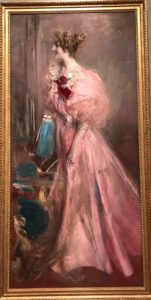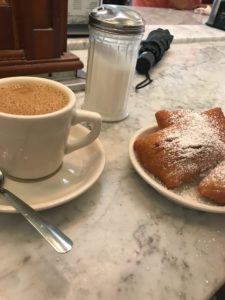This week I continued interviewing heads of each department with Ms. Abbie Edens, then Ms. Erin Clancey.
The one I’d particularly like to tell you about was Ms. Clancey’s. She is head of collections which encompasses restoration of macro-artifacts (think Sherman Tank), the forming of exhibits (which artifacts are placed, source checking, description writing), digitization of and original photographs and letters, and the preservation of micro-artifacts.
Ms. Clancey’s background is in Anthropology and I had the most interesting time speaking with her because she sees her work through the lens of humanity. Any artifact, Clancey claimed is a symbol of
“what it’s been through, who it belonged to, and what story we can tell from it”.
I love how she can see beyond the material substance in a collection and read into the life of the previous owner. For example, she was mentioning to me the work of another woman in this department, Kim Guise. Ms. Guise had for some time been reading letter after letter donated to the National WWII Museum. Most were from men fighting to their family and soulmates at home – describing what they missed about civilian life. You would be surprised by how many epistles were composed entirely of food descriptions – particulary of “apple cake” Now, Ms. Guise had never heard of apple cake. Nor had any of her coworkers. So what does she do? She finds a recipe and brings the dessert into the office the next day.
Collections is an area of work where you come face to face with a time not your own and see right through (anything you’ve been told or assumed about the era) to the raw life story underneath.
Later in the week – namely, yesterday – my Aunt Judith took me all over the city! I got to see beautiful Spanish and French architectural roots, fantastic hole-in-the-wall restaurants, and hear all about the history of New Orleans. I’m sure many of you know that New Orleans has a rich c
onnection to French culture, but what not many know is that it was in fact under French rule… then Spanish… then French again… and then finally purchased by Thomas Jefferson 1803 (hint, hint The Louisiana Purchase – sound familiar?).
Let me tell you, it is refreshing to leave Rural Colorado for a bit even just to be around populous diversity. People of all race, religion, and tongue reside here in respect and harmony.
Note: in my time here I’ve heard the terms “Cajun”, “Mulatto”, and “Creole” thrown around pretty frequently – often in conjunction with African American culture. However, it wasn’t until yesterday that I was afforded a distinction. “Cajun” directly refers to French descendancy and culture. “Mulatto” is a semi-archaic term describing a person of half black ancestry and half white ancestry. Lastly, “Creole” is defined as a first-generation immigrant – from anywhere to anywhere. These words are often misused and I find it comforting to be among those who understand and appreciate their meaning.
Anywho, with Judith I also got to see the gorgeous botanical gardens, the New Orleans Museum of Art (I frickin’ LOVE 17th century European portraiture), learn some french, and eat beignets!! What a day! Enjoy yours! Thanks for reading. 🙂
Quést-ce que je peux dire? Je sais tout!
À bientôt!



There are no comments published yet.